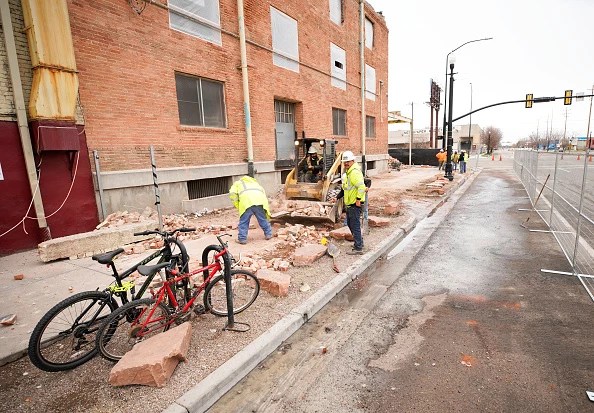
New York City is known for its towering skyscrapers, bustling streets, and vibrant culture. However, it is also a region that is not entirely immune to the forces of nature. Today, New Yorkers may be feeling a little rattled as reports of an earthquake have emerged in the area. While earthquakes are often associated with the West Coast, the reality is that they can occur anywhere, including the densely populated streets of NYC. As residents and visitors alike seek answers, let’s dive into the details surrounding the NYC earthquake today and what it means for the city.
Seismologists and emergency services are on high alert as they monitor the situation closely. Reports indicate that tremors were felt across various boroughs, causing a stir among residents who may not be accustomed to experiencing such seismic activity. As the news spreads, it’s essential to understand the implications and safety measures that should be taken in the aftermath of an earthquake. The city’s infrastructure is designed to withstand various challenges, but how well does it hold up against seismic events?
In this article, we will explore the specifics of the NYC earthquake today, including its magnitude, location, and potential impact. We will also address common questions regarding earthquake preparedness, what to do during an earthquake, and the likelihood of aftershocks. So, whether you’re a long-time resident or visiting the city for the first time, it’s crucial to stay informed and prepared for any unexpected events.
What Happened in the NYC Earthquake Today?
The recent earthquake that struck New York City has left many people wondering about its origin and effects. Reports indicate that the earthquake occurred in the early afternoon, with a magnitude of 4.2 on the Richter scale. Tremors were felt across various parts of the city, with residents sharing their experiences on social media. While the earthquake was not strong enough to cause significant damage, it did serve as a reminder of the importance of being prepared for such natural events.
Where Did the Earthquake Occur in NYC?
The epicenter of the earthquake was reported to be located in the vicinity of central Brooklyn. Residents in neighborhoods such as Park Slope and Crown Heights felt the tremors most acutely. However, reports of shaking were also received from Manhattan, Queens, and even parts of Staten Island. The widespread nature of the tremors suggests that the earthquake was felt by a large number of people, raising awareness about the potential risks associated with living in a city that is not typically known for seismic activity.
What Should You Do During an Earthquake?
Knowing how to react during an earthquake is crucial for ensuring personal safety. Here are some essential tips to keep in mind:
- Drop, Cover, and Hold On: Get down on your hands and knees, take cover under a sturdy piece of furniture, and hold on until the shaking stops.
- Stay Indoors: If you are inside, do not rush outside during the shaking, as falling debris can pose a risk.
- Move Away from Windows: Stay clear of windows, glass, and heavy objects that may fall.
- Be Aware of Your Surroundings: If you are outside, move to an open area away from buildings, trees, and power lines to avoid potential hazards.
How Prepared is NYC for Earthquakes?
New York City has implemented various measures to prepare for potential earthquakes, even though they are relatively rare in the region. Building codes have been updated to include seismic safety measures, and emergency management agencies conduct drills and preparedness campaigns to educate the public. However, the question remains: Are these measures sufficient to protect residents in the event of a significant earthquake?
What Are the Chances of Aftershocks Following the NYC Earthquake Today?
Aftershocks are common following an earthquake, especially if the initial quake was of a moderate magnitude. Seismologists indicate that aftershocks can occur within days, weeks, or even months after the main event. While they are typically less intense than the initial quake, they can still pose risks. It’s essential for residents to remain vigilant and prepared for the possibility of aftershocks.
How Can You Stay Informed About Earthquakes in NYC?
Staying informed about seismic activity in New York City is crucial for personal safety. Here are some ways to stay updated:
- Follow reputable news sources for real-time updates on earthquakes and safety information.
- Sign up for emergency alerts from the city’s Office of Emergency Management.
- Utilize apps that provide earthquake notifications and safety tips.
- Stay connected with local community groups and social media for shared experiences and advice.
Conclusion: Preparing for the Unexpected in NYC
While the NYC earthquake today may have caught many off guard, it serves as an important reminder of the need for preparedness in any urban environment. Understanding the risks and knowing how to respond can make all the difference in ensuring safety during such unexpected events. As the city continues to recover and reflect on the experience, residents are encouraged to remain aware and proactive in their earthquake preparedness efforts. The lessons learned from today’s earthquake will undoubtedly contribute to a more resilient New York City in the future.
ncG1vNJzZmivp6x7o77EnKKepJxjwqx7w6KqnKemmr%2BmsJJopbKbXZqus8DHqqyao5ViwbCwwLJloaydoQ%3D%3D